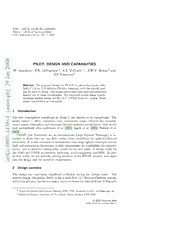
PILOT: design and capabilities PDF
Preview PILOT: design and capabilities
Title : will be set by the publisher Editors : will be set by the publisher EAS Publications Series, Vol. ?, 2008 8 0 PILOT: DESIGN AND CAPABILITIES 0 2 W. Saunders1, P.R. Gillingham 1, A.J. McGrath 1, J.W.V. Storey2 and n J.S. Lawrence2 a J 9 2 Abstract. The proposed design for PILOT is a general-purpose, wide- field(1◦)2.4m,f/10Ritchey-Chr´etientelescope,withfasttip-tiltguid- h] ing,foruse0.5−25µm. Thedesignallowsbothwide-fieldanddiffraction- p limited use at these wavelengths. The expected overall image quality, - includingmedianseeing,is0.28−0.3′′ FWHMfrom0.8−2.4µm. Point o source sensitivities are estimated. r t s a 1 Introduction [ 1 The free atmospheric conditions at Dome C are known to be exceptional. The v seeing (above ∼ 30m), coherence time, isoplanatic angle, infrared sky emission, 8 watervapourabsorptionandtelescope thermalemissionareallbetter thanatthe 3 4 best mid-latitude sites (Lawrence et al. 2004, Agabi et al. 2006, Walden et al. 4 2005). 1. PILOT (the Pathfinder for an International Large Optical Telescope) is in- 0 tended to show that we can fully utilise these conditions for optical/infra-red 8 astronomy. It is also intended to demonstrate that large optical telescopes can be 0 builtandoperatedinAntarctica;tofullycharacterisethepossibilitiesforadaptive : v optics; and to perform cutting-edge science in its own right. A design study by i the AAO and UNSW is currently underway, with completion mid-2008. As part X of that study, we are actively seeking partners in the PILOT project, and input r a into the design and the scientific requirements 2 Design overview The design has undergone significant evolution during the design study. The ◦ current design (December 2007), is for a wide-field (1 ) Ritchey-Chr´etien system, with2.4mprimary,tip-tiltsecondary,correctorlensesforwide-fielduse,2Nasmyth 1 Anglo-AustralianObservatory,Epping,NSW1710,Australia;e-mail: [email protected] 2 School ofPhysics,UniversityofNewSouthWales,Sydney, NSW2052 (cid:13)c EDPSciences 2008 DOI:(willbeinsertedlater) 2 Title : will be set by the publisher Fig.1.OpticallayoutforPILOT,forwide-fieldoptical(r-band)usewith1◦field(above) andwide-fieldinfra-red(Kdark-band)usewith15′ fieldandcold stop(below). Thespot diagrams (on right) include the Airy disc and a scale bar of 18µm/0.15′′ (above) and 72µm/0.62′′ (below). The optical design is diffraction limited above500nm. foci, and f/10 overall speed. It will be on a ∼ 30m tower, and enclosed in a thermally and humidity-controlled dome. All routine operations will be remotely controlled. A Gregoriandesignoffersa potential advantagefor tip-tilt correction,because oftheconjugacyofthesecondarytoresidualboundarylayerturbulence. However, we calculate that this gain is very small in practice, and far outweighed by the drawbacks of a faster primary, a larger secondary and smaller field of view. Originally, it was envisaged that Narcissus mirrors would be used for thermal baffling (Gillingham 2002). However, they interfere with other instrumentation, reducingflexibility. AlsotheverticaltemperaturegradientatDome-Cmeansthat a telescope at 30m elevation is much warmer (∼ −45◦ C) than one at ground level, and the relative emission from sky and telescope is very similar to that at a temperate site. Therefore, we have moved to a cold-stop design for the infrared camera, improving the performance and allowing a much more general-purpose telescope design. PILOT: design and capabilities 3 3 Instrumentation 1. There will be a fast readout, zero-noise camera based on an L3Vision 1K x 1K detector, with ∼ 0.02′′ pixels. This will allow optical “Lucky Imaging”, with ∼ 50% of short-exposure frames being diffraction-limited at 800nm in normal conditions. In future, this camera could be given adaptive optics correction to allow diffraction-limited imaging down to 500nm. 2. Therewillbeawidefieldvisiblecamerasamplingthetip-tilt-correctednatu- ralseeing,over40′×40′. ThismightuseSTA10Kx10Kdetectorswith9µm ′′ (0.077 ) pixels , or, if available, we would use Orthogonal Transfer CCDs. The image quality and science potential for this is discussed in Saunders 2008. 3. The infraredcamerais designedfor 1−5µm use. The coldstopis anOffner relay. Thedetectorisafocalplanearrayof4k×4kHawaiiII-RGwith18µm 0.154′′ pixels, giving diffraction-limited imagingat KLMovera 10.5′×10.5′ field of view. There will be an optional Barlow lens beam expander, giving f/25 imaging, and allowing properly sampled diffraction-limited images at zyJH bands whenever atmospheric conditions allow. The telescope optics allow an upgrade to much larger detector area, with up to 4 such arrays. 4. There will be a mid-infrared camera, using a single Aquarius 1K × 1K de- tector, allowing narrow-bandimaging at 17 and 21µm, across ∼0.5◦. 4 Image quality We havemodelledthe averageC2 profile determinedbyAgabiet al. 2006. There N is some residual turbulence in the bounday layer above the telescope, but we can correctfor most of this with a fast tip tilt secondary,over the entire field of view. We find that the potential median image quality (diffraction + tip-tilt-corrected seeing) is <0.3′′ for 0.5−2µm (Figure 4). The telescope is designed to meet this potential. The specification for image degradationcausedbythetelescope,includingdomeandmirrorseeing,windshake, ′′ ′′ guidingerrorsandoptics,is0.20 80%encircledenergydiameter,or0.13 FWHM. Theexpectedoverallimagequalityisremarkablyuniformover0.8−2.4µm,inthe range 0.28−0.3′′. 5 Sensitivity Theestimatedpointsourcesensitivities,basedontheimagesizesandbackgrounds above, are given below. The magnitude limit at Kdark is 2-3 magnitudes deeper than VISTA, and deep enough to match the big optical sky surveys such as VST. Other scientific possibilities are outlined in Burton et al. 2005, Burton 2008, and Saunders 2008. 4 Title : will be set by the publisher Fig. 2. Delivered image quality as a function of wavelength, showing the contributions from median seeing, tip-tilt correction, diffraction and telescope. Band V I J H Kdark Ldark L M λ(µm) 0.55 0.8 1.2 1.65 2.35 2.9 3.8 4.7 ∆λ(µm) 0.09 0.15 0.26 0.29 0.23 0.20 0.65 0.24 ′′2 Sky (Jy/ ) 6E-6 2E-5 5E-4 1E-3 1E-4 2E-3 2E-1 5E-1 ′′2 Sky (AB/ ) 22.0 20.7 17.2 16.4 18.9 15.7 10.7 9.7 AB, 1hr 5σ 27.4 26.8 25.3 24.8 25.6 23.5 21.1 19.6 References Agabi, A., Aristidi, E., Azouit, M., Fossat, E., Martin, F., Sadibekova, T., Vernin, J. & Ziad, A.2006, PASP,118, 344 Burton, M.G. 2008, these proceedings Burton, M.G., Lawrence, J.S., Ashley,M.C.B., et al. 2005, PASA,22, 199 Lawrence, J. S., Ashley,M. C. B., Travouillon, T. & Tokovinin, A.2004, Nat,431, 278 Gillingham, P.R.2002, PASA,19, 301 Saunders,W. 2008, these proceedings Walden, V.P,Town, M.S., Halter, B. & Storey,J.W.V. 2005, PASP,117, 300
